#AR 3664
Text
Gök Kubbe Aurorası
Günün Astronomi Görseli 20 Mayıs 2024
Görsel & Telif: Xuecheng Liu & Yuxuan Liu
Gece gibi görünse de gökyüzünün bir kısmı mor renkte parlıyordu. Bu, dünyanın büyük bir bölümünde insanların güzel auroralarla dolu gökyüzü gördüklerini bildirdikleri o meşhur 10 Mayıs 2024 gecesiydi. Öne çıkan görüntü o gece sabahın erken saatlerinde ABD’nin Wisconsin eyaletindeki Arlington kentinden çekildi.…

View On WordPress
4 notes
·
View notes
Link
Prepare to traverse the interstellar realm with today's episode of Astronomy Daily - The Podcast, where your cosmic navigator, Anna, unveils the universe's latest wonders.
Today, we're peering through the Hubble Space Telescope to glimpse a newly discovered triple star system, navigating the complexities of Boeing's Starliner mission, and marveling at India's ambitious plans for Mangalyaan Two's Mars adventure. Join us as we delve into the effects of a massive sunspot on Mars and lay the foundation for humanity's lunar future with NASA's Artemis IV mission and the Gateway space station.
Fasten your seatbelts for a celestial ride through the cosmos!
(00:00) Welcome to Astronomy Daily, your go to podcast for the latest space news
(00:48) Hubble recently revealed a stunning image of the triple star system HP Tau
(02:35) First crew flight test for Boeing Starliner delayed due to helium leak
(05:47) Solar flare on May 14 could significantly impact Mars upper atmosphere
(07:30) NASA's Artemis four mission will herald a new chapter in lunar exploration
For an immersive experience of the universe, visit our website at astronomydaily.io, and join the conversation on X (@AstroDailyPod) for daily updates and celestial camaraderie.
Until our next cosmic journey, this is Anna reminding you to keep your eyes on the skies and your spirit of discovery alive. Clear skies and cosmic wonder to all our fellow space enthusiasts!
This episode is brought to you with the support of our galactic sponsors, including NordPass, the password manager you need in your life. It's the one we use and swear by. Get our special deal by visiting www.bitesz.com/nordpass. Check out all our great sponsor deals on our website.
Become a supporter of this podcast: https://www.spreaker.com/podcast/astronomy-daily-the-podcast--5648921/support.
#3664#ar#artemis#boeing#gateway#hubble#india#iv#lunar#mars#mission#nasa#space#star#starliner#station#sunspot#system#telescope#triple
0 notes
Text
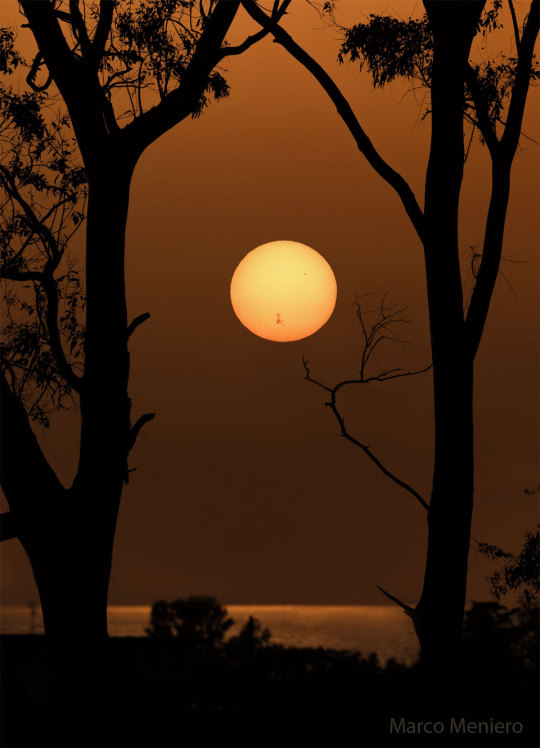
AR 3664 Sunspot Region on a Setting Sun ©
#sun#nasa#apod#sunset#astrophotography#solar system#planet#night#stars#sky#astronomy#universe#cosmos#galaxy
1K notes
·
View notes
Text
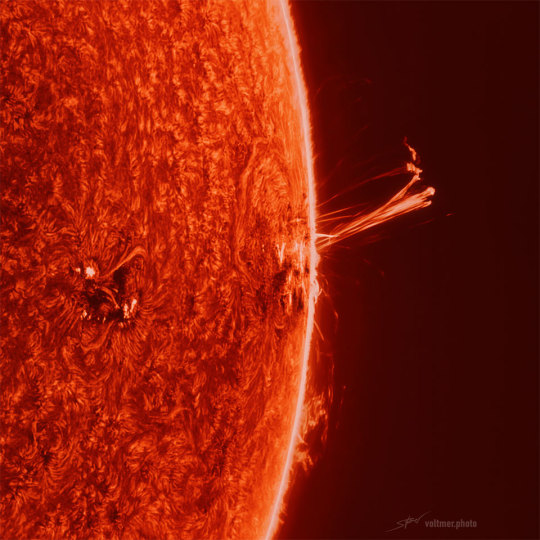
AR 3664 at the Sun's Edge
236 notes
·
View notes
Text
AR 3664 on the Sun // wen_astroevo
This is the sunspot that caused the aurora to be visible this past weekend!
#astronomy#astrophotography#video#solar system#star#sun#the sun#sol#solar activity#solar surface#sunspot
168 notes
·
View notes
Photo
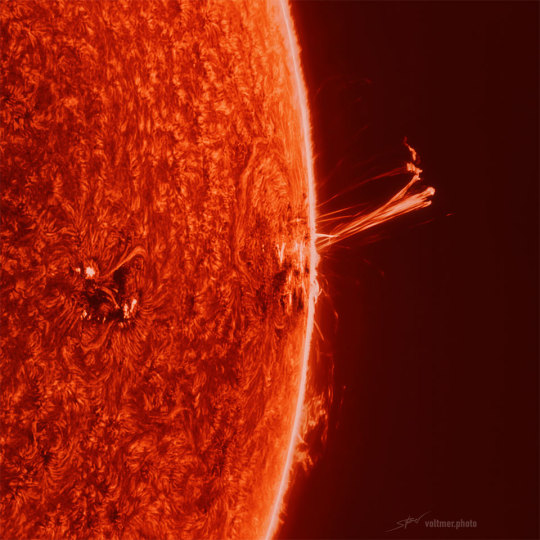
2024 May 15
AR 3664 at the Sun's Edge
Image Credit & Copyright: Sebastian Voltmer
Explanation: What did the monster active region that created the recent auroras look like when at the Sun's edge? There, AR 3664 better showed its 3D structure. Pictured, a large multi-pronged solar prominence was captured extending from chaotic sunspot region AR 3664 out into space, just one example of the particle clouds ejected from this violent solar region. The Earth could easily fit under this long-extended prominence. The featured image was captured two days ago from this constantly changing region. Yesterday, the strongest solar flare in years was expelled (not shown), a blast classified in the upper X-class. Ultraviolet light from that flare quickly hit the Earth's atmosphere and caused shortwave radio blackouts across both North and South America. Although now rotated to be facing slightly away from the Earth, particles from AR 3664 and subsequent coronal mass ejections (CMEs) might still follow curved magnetic field lines across the inner Solar System and create more Earthly auroras.
∞ Source: apod.nasa.gov/apod/ap240515.html
169 notes
·
View notes
Text

Andrea Vanoni
The return of the Queen (ex AR 3664)
Telescope: Achromatic 152/900
57 notes
·
View notes
Text
2024 May 17

Aurora Banks Peninsula
Image Credit & Copyright: Kavan Chay
Explanation: This well-composed composite panoramic view looks due south from Banks Peninsula near Christchurch on New Zealand's South Island. The base of a tower-like rocky sea stack is awash in the foreground, with stars of the Southern Cross at the top of the frame and planet Earth's south celestial pole near center. Still, captured on May 11, vibrant aurora australis dominate the starry southern sea and skyscape. The shimmering southern lights were part of extensive auroral displays that entertained skywatchers in northern and southern hemispheres around planet Earth, caused by intense geomagnetic storms. The extreme spaceweather was triggered by the impact of coronal mass ejections launched from powerful solar active region AR 3664.
Authors & editors: Robert Nemiroff (MTU) & Jerry Bonnell (UMCP)
30 notes
·
View notes
Text
2024 May 28
youtube
Solar X Flare as Famous Active Region Returns
Video Credit: NASA, Solar Dynamics Observatory
Explanation: It's back. The famous active region on the Sun that created auroras visible around the Earth earlier this month has survived its rotation around the far side of the Sun -- and returned. Yesterday, as it was beginning to reappear on the Earth-facing side, the region formerly labeled AR 3664 threw another major solar flare, again in the highest-energy X-class range. The featured video shows the emerging active region on the lower left, as it was captured by NASA's Earth-orbiting Solar Dynamics Observatory yesterday in ultraviolet light. The video is a time-lapse of the entire Sun rotating over 24 hours. Watch the lower-left region carefully at about the 2-second mark to see the powerful flare burst out. The energetic particles from that flare and associated CME are not expected to directly impact the Earth and trigger impressive auroras, but scientists will keep a close watch on this unusually active region over the next two weeks, as it faces the Earth, to see what develops.
#astronaut#astronomers#not astrology#star#stars#art#astronomy#outer space#space#youtube#aurora borealis#aurora#auroras#sun#solar#flares#flare#ultraviolet light#NASA#video
11 notes
·
View notes
Text
youtube
Solar X Flare as Famous Active Region Returns, 2024-05-28
It's back. The famous active region on the Sun that created auroras visible around the Earth earlier this month has survived its rotation around the far side of the Sun -- and returned. Yesterday, as it was beginning to reappear on the Earth-facing side, the region formerly labeled AR 3664 threw another major solar flare, again in the highest-energy X-class range. The featured video shows the emerging active region on the lower left, as it was captured by NASA's Earth-orbiting Solar Dynamics Observatory yesterday in ultraviolet light. The video is a time-lapse of the entire Sun rotating over 24 hours. Watch the lower-left region carefully at about the 2-second mark to see the powerful flare burst out. The energetic particles from that flare and associated CME are not expected to directly impact the Earth and trigger impressive auroras, but scientists will keep a close watch on this unusually active region over the next two weeks, as it faces the Earth, to see what develops.
Credits: NASA's 'Astronomy Picture Of The Day.'
3 notes
·
View notes
Text
*assembles NOAA forecasts on a separate post for my sanity*
Ignore the madhat notes



:Product: Forecast Discussion
:Issued: 2024 May 29 0030 UTC
Prepared by the U.S. Dept. of Commerce, NOAA, Space Weather Prediction Center
#
Solar Activity
.24 hr Summary…
Solar activity was at low levels with numerous C-class flares. The main
culprits of this activity were ARs 3691 (N27E20, Ekc/beta-gamma-delta)
and 3697 (S18E69, Eho/beta-gamma). The largest flare of the period
originated from AR3697 as a C8.9 at 28/1841 UTC. Region 3697 has yet to
fully rotate into view, making proper classification precarious at best
while 3691 was little changed. Region 3692 (S08W24, Cro/beta) exhibited
decay in its trailing spots, and 3693 (N05E07, Dao/beta) continued to
increase the separation between its leading and trailing groups. The
remaining active regions were relatively stable and quiet. An asymmetric
halo CME, first observed in LASCO coronagraph imagery at approximately
28/0524 UTC, was deemed to be a far-sided event, thus no Earth-directed
CMEs were observed in available coronagraph imagery.
.Forecast…
Solar activity will likely reach moderate levels with a few M-class
flares (R1-2/Minor-Moderate Radio Blackouts) while maintaining a chance
for isolated X-class flares (R3/Strong Radio Blackouts) through 31 May.
Energetic Particle
.24 hr Summary…
The greater than 2 MeV electron flux was normal to moderate and the
greater than 10 MeV proton flux remained at background values.
.Forecast…
The greater than 2 MeV electron flux is expected to remain at normal to
moderate levels through 30 May. There is a slight chance for a greater
than 10 MeV proton event exceeding the S1 (Minor) threshold through 31
May primarily due to the flare potential of Regions 3691 and 3697.
Solar Wind
.24 hr Summary…
Solar wind parameters were at or near nominal levels. Solar wind speed
averaged below 350 km/s. Total field ranged from 1-7 nT while the Bz
component was between +5/-4 nT. Phi became predominantly positive after
approximately 28/0607 UTC.
.Forecast…
An enhancement in the solar wind environment due to indirect shock
arrival from the 27 May X2.8 flare event may arrive by late 29 May. The
solar wind environment is expected to return to ambient-like levels over
the course of 30 May and remain there through 31 May.
Geospace
.24 hr Summary…
The geomagnetic field was at quiet levels.
.Forecast…
Isolated active levels, with a chance for G1 (Minor) storming, are
expected on 29 May with any shock arrival from the 27 May CME. Quiet to
unsettled conditions are expected on 30 May as any lingering shock
effects wane. Mostly quiet conditions are anticipated to prevail 31 May.

Forecast of Solar and Geomagnetic Activity
27 May - 22 June 2024
Solar activity is expected to be at a chance for moderate (R1-R2 /
Minor-Moderate) levels due to the return of previous active region
3664 (S17, L=347).
There will be a slight chance of S1 (Minor) solar radiation storms
from 28 May through 09 Jun upon the return of old region 3664.
The greater than 2 MeV electron flux at geosynchronous orbit is
expected to be at low to moderate levels.
Geomagnetic field activity is expected to be at unsettled to active
levels on 27-28 May and 08-12 Jun due to the influence of positive
polarity CH HSSs. Mostly quiet levels are expected on 29-31 May,
01-07 Jun and 13-22 Jun.
0 notes
Text
Güneş'in Kenarında AR 3664
Günün Astronomi Görseli 15 Mayıs 2024
Görsel & Telif: Sebastian Voltmer
Son auroraları oluşturan canavar aktif bölge Güneş’in kenarındayken neye benziyordu? İşte AR 3664 orada 3 boyutlu yapısını daha iyi gösteriyor. Fotoğrafta, kaotik güneş lekesi bölgesi AR 3664’ten uzaya doğru uzanan, bu şiddetli güneş bölgesinden püskürtülen parçacık bulutlarının sadece bir örneği olan çok çatallı büyük…
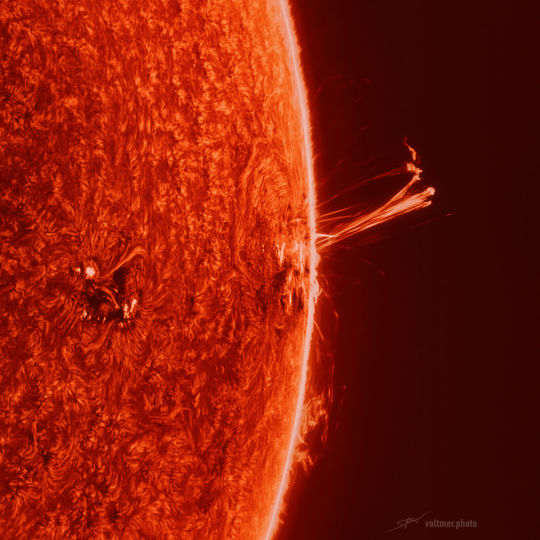
View On WordPress
#apod#AR 3664#astronomi#astronomy#bilim#gökyüzü#güneş aktivitesi#güneş lekesi#Nasa#repost#science#sky#space#uzay#uzaydanhaberler
2 notes
·
View notes
Link
Embark on a celestial sojourn with today's episode of Astronomy Daily - The Podcast, where the wonders of the cosmos unfold before our very ears.
Join your host, Steve Dunkley, and the ever-cheeky AI companion, Hallie, as they navigate the afterglow of a recent solar spectacle and delve into the latest space-faring innovations.
We kick things off with a colorful discussion about the recent auroras that have painted the skies with otherworldly hues, as seen through the lens of our global community.
From there, we dive into the heart of our solar system, examining the sun's fiery temperament and its most powerful flares that have supercharged Earth's auroras and challenged our technological resilience.
1. **Auroral Afterglow**: Hallie and Steve share the global aurora experiences.
2. **Solar Storm Spectacle**: A deep dive into the sun's recent outburst of flares.
3. **Spinlaunch's New Horizon**: Exploring the leadership change at the forefront of space innovation.
4. **Voyager's Enduring Journey**: An update on the Voyager probes' remarkable 46-year odyssey.
5. **Geomagnetic Revelations**: Understanding the impact of solar activity on Earth's technology.
Get ready to be enlightened by the tales of human fascination with the night sky's beauty and the relentless pursuit of cosmic understanding.
For the full astronomical experience, visit our new URL at astronomydaily.io and subscribe to receive the Astronomy Daily newsletter in your inbox. Engage with us on X (@AstroDailyPod) or join the Space Nuts podcast group on Facebook to share your celestial sightings and thoughts.
Until next time, let your curiosity lead you to the stars, and remember, in the grand tapestry of the universe, every story is interwoven with the threads of discovery. Clear skies and cosmic wonder to all our fellow stargazers!
This episode of Astronomy Daily - The Podcast is a journey through the vibrant auroras to the sun's magnificent flares, the innovative minds at Spinlaunch, and the enduring legacy of the Voyager probes.
Tune in for a cosmic update that connects the dots between the beauty of the night sky and the intricate dance of celestial forces.
This episode was brought to you with the assistance of NordPass....the password manager we use and swear by. Check out our very special deal by visiting www.bitesz.com/nordpass.
#3664#ar#aurora#australis#ceo#david#flare#jet#laboratory#probes#propulsion#solar#space#spinlaunch#storm#sunspot#voyager#weather#wren#x-class
0 notes
Text
youtube
Solar X Flare as Famous Active Region Returns
Video Credit: NASA, Solar Dynamics Observatory
“Explanation: It's back. The famous active region on the Sun that created auroras visible around the Earth earlier this month has survived its rotation around the far side of the Sun -- and returned. Yesterday, as it was beginning to reappear on the Earth-facing side, the region formerly labeled AR 3664 threw another major solar flare, again in the highest-energy X-class range. The featured video shows the emerging active region on the lower left, as it was captured by NASA's Earth-orbiting Solar Dynamics Observatory yesterday in ultraviolet light. The video is a time-lapse of the entire Sun rotating over 24 hours. Watch the lower-left region carefully at about the 2-second mark to see the powerful flare burst out. The energetic particles from that flare and associated CME are not expected to directly impact the Earth and trigger impressive auroras, but scientists will keep a close watch on this unusually active region over the next two weeks, as it faces the Earth, to see what develops.”
0 notes
Text
Esta vista panorâmica composta bem composta olha para o sul da Península de Banks, perto de Christchurch, na Ilha Sul da Nova Zelândia. A base de uma pilha rochosa em forma de torre está inundada em primeiro plano, com as estrelas do Cruzeiro do Sul no topo da moldura e o pólo celeste sul do planeta Terra perto do centro. Ainda assim, capturada em 11 de maio, a vibrante aurora austral domina o mar estrelado do sul e a paisagem celeste. As cintilantes luzes do sul faziam parte de extensas exibições aurorais que entretinham os observadores do céu nos hemisférios norte e sul do planeta Terra, causadas por intensas tempestades geomagnéticas. O clima espacial extremo foi desencadeado pelo impacto das ejeções de massa coronal lançadas pela poderosa região solar ativa AR 3664.

Crédito da imagem e direitos autorais: Kavan Chay
Fonte: https://twitter.com/apod/status/1791652151321825529?t=6AGnFXTziHOgtub_uu80bg&s=19
0 notes
Photo
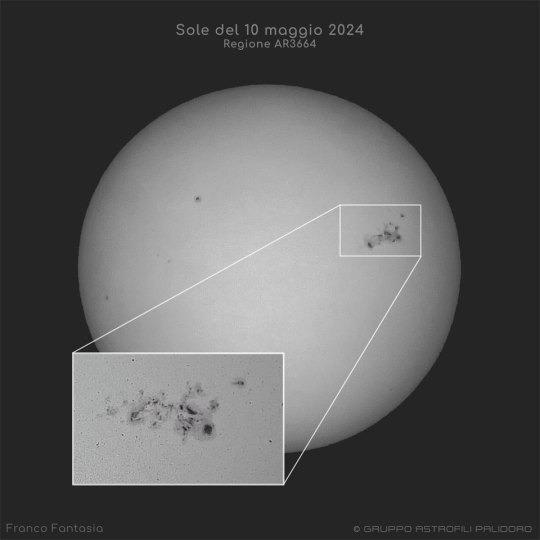
2024 May 11
AR 3664: Giant Sunspot Group
Image Credit & Copyright: Franco Fantasia & Guiseppe Conzo (Gruppo Astrofili Palidoro)
Explanation: Right now, one of the largest sunspot groups in recent history is crossing the Sun. Active Region 3664 is not only big -- it's violent, throwing off clouds of particles into the Solar System. Some of these CMEs are already impacting the Earth, and others might follow. At the extreme, these solar storms could cause some Earth-orbiting satellites to malfunction, the Earth's atmosphere to slightly distort, and electrical power grids to surge. When impacting Earth's upper atmosphere, these particles can produce beautiful auroras, with some auroras already being reported unusually far south. Pictured here, AR3664 and its dark sunspots were captured yesterday in visible light from Rome, Italy. The AR3664 sunspot group is so large that it is visible just with glasses designed to view last month's total solar eclipse. This weekend, skygazing enthusiasts will be keenly watching the night skies all over the globe for bright and unusual auroras.
∞ Source: apod.nasa.gov/apod/ap240511.html
203 notes
·
View notes